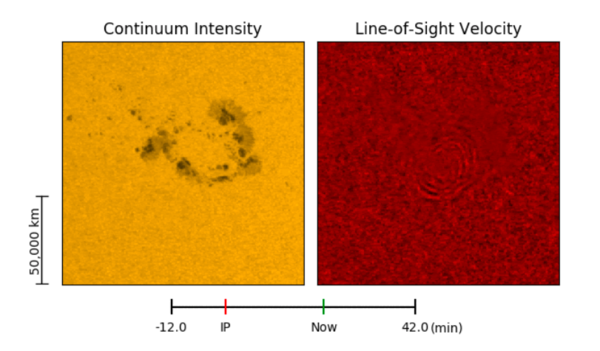Submerged Flare Acoustic Sources
From RHESSI Wiki
| Nugget | |
|---|---|
| Number: | 388 |
| 1st Author: | Juan Camilo BUITRAGO CASAS |
| 2nd Author: | Angel MARTÍNEZ |
| Published: | 13 September 2020 |
| Next Nugget: | TBD |
| Previous Nugget: | Circular Ribbon Flare at Microwaves |
| List all | |
Contents |
Introduction
A major new discovery about solar flares appeared as recently as 1997, when a set of concentric, expanding ripples appeared on the solar surface immediately following the flare SOL1996-07-09 (see earlier Nuggets No. 26 and No. 127). These phenomena hold great interest because they come from acoustic waves launched by the flare that surprisingly penetrate into the Sun's deep interior, and that contain substantial fractions of the flare's total energy. At present no broadly accepted theory exists.
These events are hard to detect because the ripples have small amplitudes, comparable in fact to the ubiquitous photospheric variability due to convection and the "p-mode" global oscillations. Recently an extraordinarily impulsive flare, SOL2016-07-23, produced an acoustic event that has led to the discovery described here (Ref. [2]). Figure 1 shows one frame from a [movie] that shows the development of the ripples.

Solar Acoustic Holography
This subject may sound forbiddingly arcane, but in essence it is simple: one observes the ripples, and then propagates them analytically back through the solar interior, knowing the speed of sound, until they converge on the source. The analogy with optical ray tracing is exact. The source location (and its shape) can be estimated in all three dimensions, much as with the formation of an image at the focal plane of a telescope. For this flare the source is quite compact, close to the resolution limit imposed by the diffraction of the acoustic wave front. Figure 2 shows the layout graphically.
A deep source
The holographic imaging of the acoustic source in this event resulted in a major surprise. Not only was the source compact, not much larger than the diffraction limit of the reconstruction, but it lay at a significant depth below the photosphere (Ref. [3]). The analysis gives a depth of 1150 +- 200 km below the nominal photosphere as defined by τ5000 Â = 1.
Conclusions
Acknowledgements
Charlie Lindsey, Juan Carlos Martínez Oliveros, and Hugh Hudson helped with this Nugget.
References
[1] "X-ray flare sparks quake inside Sun"
[2] "Ultra-impulsive Solar Flare Seismology"
[3] "Submerged Sources of Transient Acoustic Emission from Solar Flares"
| RHESSI Nugget Date | 13 September 2020 + |
| RHESSI Nugget First Author | Juan Camilo BUITRAGO CASAS + |
| RHESSI Nugget Index | 388 + |
| RHESSI Nugget Second Author | Angel MARTÍNEZ + |
